The Airbus A320 and the Boeing 737 aircraft are the workhorses of the aviation industry. While both have seen an evolution over time, the real step change has been at the end of Airbus, who had the neo version come up about a decade ago. The Neo was an evolution in engine technology that promised a 15% reduction in fuel burn, which is a lot for an airline, given that fuel is one of the biggest bills an airline pays, and 15% could be the difference between profit and loss on a flight. Boeing responded with the MAX.
The A321 origin story
The stretched version of the A320, the A321, has been in service since 1993, about five years after the A320 entered service. Over time, the A321 also received neo-technology improvements. The A321neo has been used for a while to replace widebodies on various medium-haul routes.
For instance, La Compagnie is a French airline that started operations in 2014 with a couple of Boeing 757-200 but pivoted to A321neo aircraft as part of its fleet renewal. The airline operates in all-business class and uses the A321neo to fly 3600-4000 mile-long routes daily. The airline also has A321neo LR on order.

La Compagnie Route Network
Other airlines, such as JetBlue have taken the lead from there. JetBlue now offers daily service between the US East Coast (New York and Boston) and London, Paris and Amsterdam on the A321LR, closer to the range of the aircraft, as intended for 206 passengers.
These are true examples of how long routes can be cracked with the A321 aircraft. Closer home, the furthest the A321neo is being sent for now is between Delhi and Hong Kong, which is a distance of 2331 miles on a great circle basis at the moment, of course, configured more densely in some cases (IndiGo).
The A321XLR is coming up.
Now, we stand at the next cusp of evolution. The A321 will enter the territory of long-haul aircraft, a single-aisle aircraft, in the domain of widebody aircraft. And that is where things get interesting for the aircraft’s customers (i.e., the airlines) and the airline’s customers (i.e., the passengers). Route networks and network planners will truly explore this aircraft’s potential, over 500 of which are currently on order.
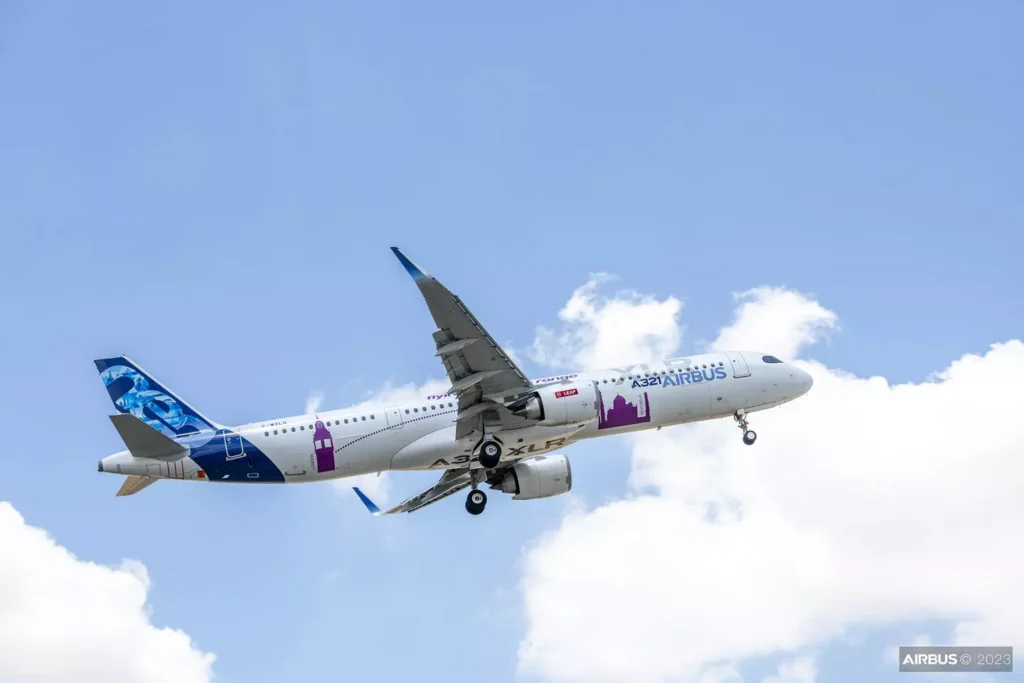
The A321XLR Test Aircraft
The Airbus A321XLR received its type certification for the CFM LEAP-1A from the European Union Aviation Safety Agency (EASA), Airbus’s regulator, right before the Farnborough Airshow 2024 went underway. The type certification for the P&W engine will happen later in 2024. As confirmed to FlightGlobal, the initial certification is for a maximum take-off weight (MTOW) of 97 tonnes, which is not in line with the 2019 statement of Airbus around a 101-tonne MTOW.
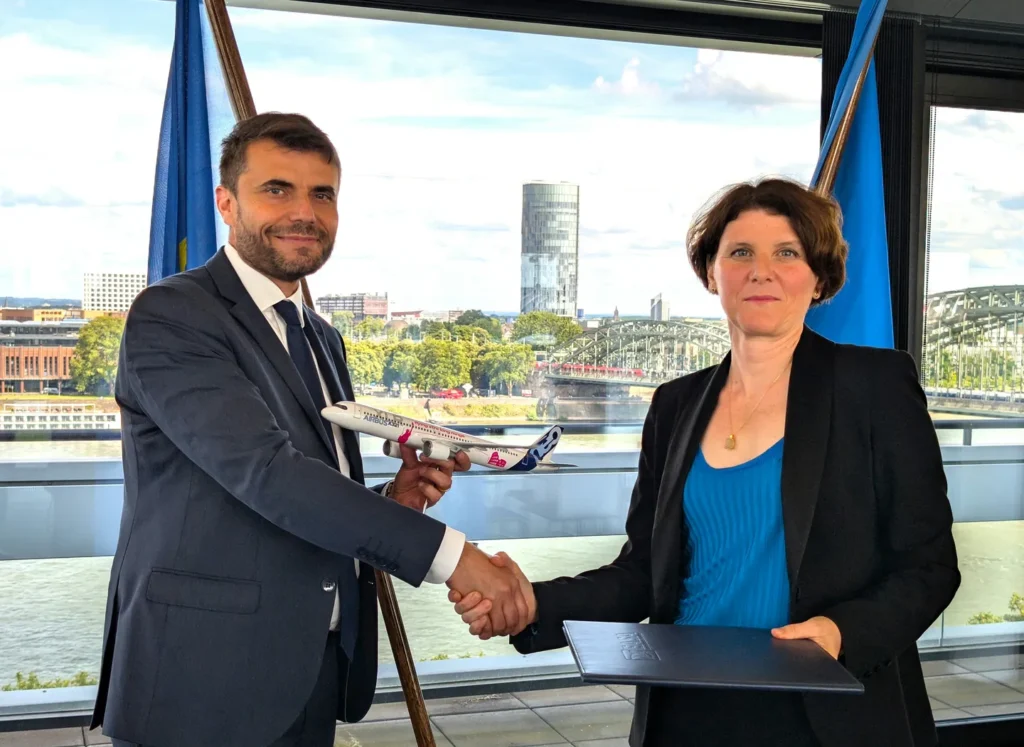
Florian Guillermet, Executive Director of EASA, is handing over the type certificate to Isabelle Bloy, Chief Engineer of the A321XLR.
The A321XLR will fill a niche created decades ago by the Boeing 757, which entered service in 1983. The stretched version, the B757-300, was colloquially called “The Flying Pencil.” The 757 was the only narrowbody aircraft capable of flying long-haul in the true sense back in the day. Airbus says their new variant, A321XLR, will have about 30% lower fuel burn than the predecessor.
The A321XLR could mean that airlines such as IndiGo won’t have to fly hub-and-spoke between some markets. Rather, they could operate direct flights between smaller markets if they think they’ll fill up these aircraft; for instance, they can fly between Gujarat (Ahmedabad) and deep into Africa, skipping a Delhi or Mumbai hub. However, these flights will have to do with a lower cargo capacity, given the aircraft will have a lot of that space directed to the rear centre tank that is being put in the belly of the aircraft.
With the RCT, the A321XLR is expected to fly up to 4700 nautical miles in a 220 pax configuration and easily operate from anywhere in India to most of Europe. Whether this range will be delivered or whether a lower range will be available remains to be seen. Due to the safety requirements, the aircraft has turned up a touch heavier than originally planned, so the range needs to be studied when in operation.
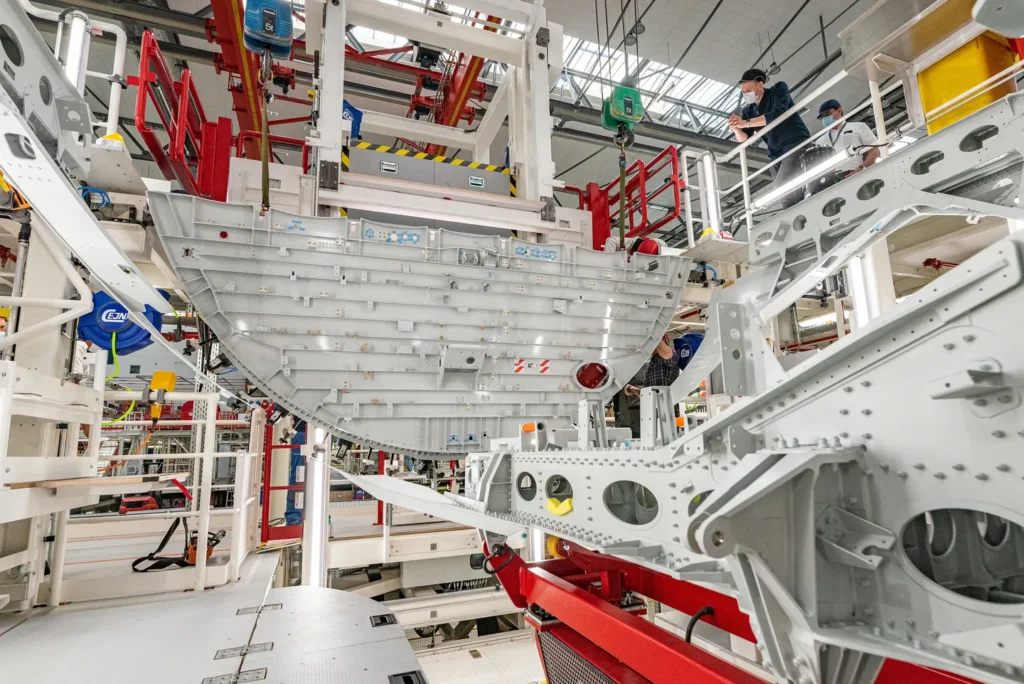
The first Rear Center Tank in Production (Image via Airbus)
Airbus had to address safety issues raised by the EASA concerning the additional fuel tank, and the OEM had to rework the insulation to address those concerns. Fuel is usually stored on the wings, and in this case, given the passenger floor-to-belly nature of the initial proposal of the XLR’s RCT, the concerns were around a case where a belly landing could cause a fire.
Iberia is set to be the launch operator of the A321XLR.
The International Airlines Group (IAG), which owns British Airways, Iberia, and Aer Lingus, among other carriers, placed an order for 14 of the A321XLR aircraft at the Paris Airshow 2019, where the XLR was first announced. The conglomerate designated eight aircraft for Iberia and 6 for Aer Lingus. Aer Lingus was going to be the launch operator of the kind. Still, after a pay dispute at Aer Lingus was not resolved, IAG switched the launch operations to Iberia.
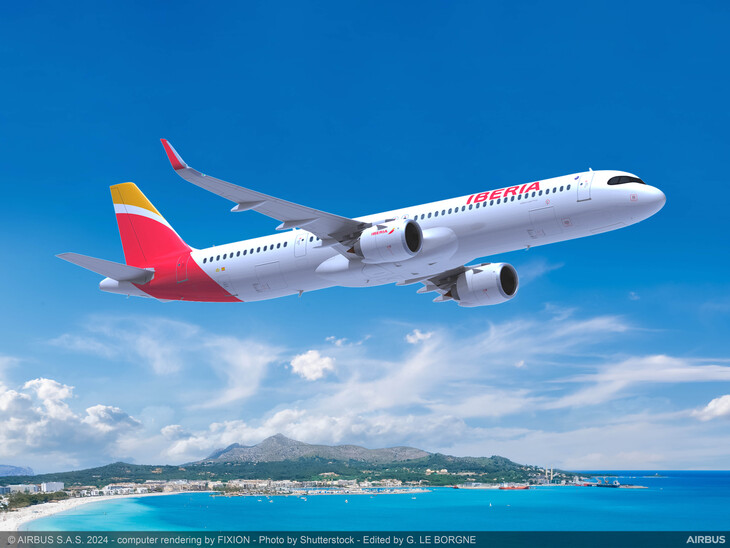
Iberia will have 182 seats arranged in a Business and Economy cabin configuration and various improvements that offer greater comfort to passengers, such as larger overhead compartments, which can store up to 60 % more carry-on suitcases, six different cabin lighting styles, and an innovative panel at the entrance to the plane, among others.
In its Business cabin, the A321XLR will have 14 individual window seats with direct access to the aisle. These will be ‘full flat’ seats that convert into beds, a wide leather headrest, compartments for personal items, and a structure that offers great comfort and privacy. All Business seats have an 18-inch individual 4K screen, offering sharper images and better tones in dark mode.
While there are no pictures published yet, there is a hint on the business cabin in the media releases, which might have been put out inevitably. Here is what the Business Cabin will look like.

Iberia A321XLR Business Class
The Airbus A321XLR will have 168 seats in the Economy cabin with the latest Recaro model, the CL3810, now called the Recaro R3, which evolved from the seats on current long-haul aircraft, with a four-inch recline and leather headrests. The seats will have two additional pockets to store personal items.
All cabins in the new A321XLR will allow passengers to bring their own headphones and connect them via Bluetooth. In addition, they have improved type A and C USB charging ports. The seat trays allow customers to place their electronic devices so they can use them more comfortably.
At the A321XLR cabin demonstrator that Airbus set up at the Airlines Interior Expo in Hamburg, the seats looked comfortable enough, even in Economy.

The A321XLR demonstrator
Airbus will bring its Airspace interiors to the XLR, including bigger bins for bags to be stowed overhead.
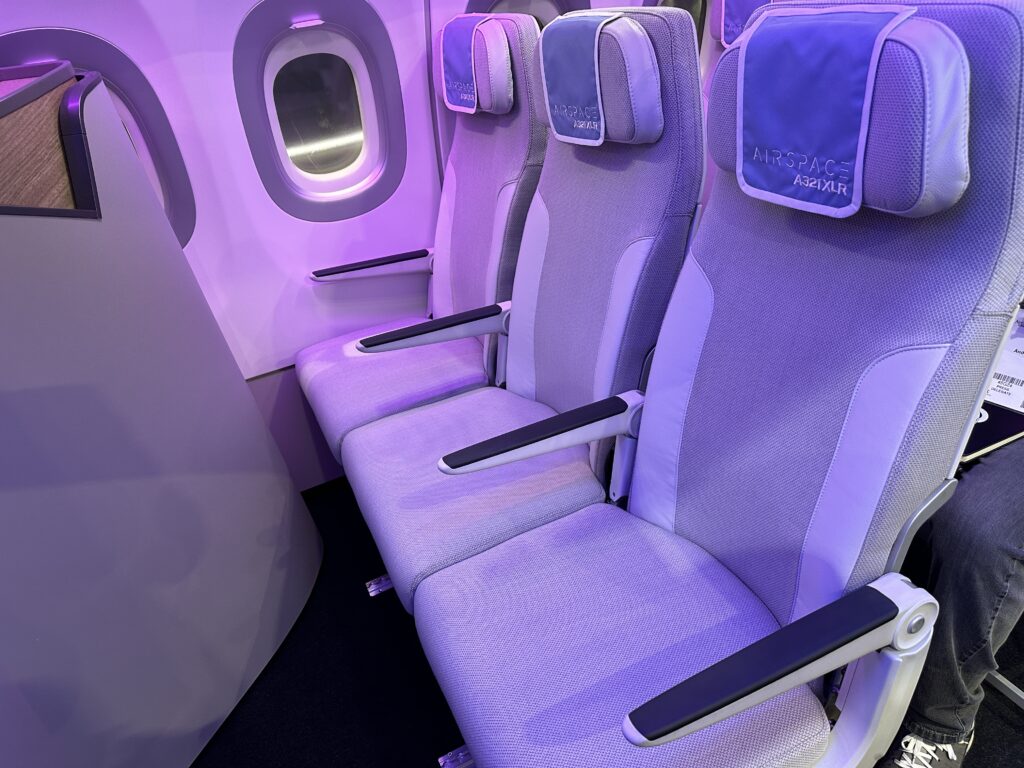
The delivery of the first XLR is slated for the summer of 2024 to Iberia, and from there, the first flight is set to operate between Madrid and Boston on November 14, 2024. Initially, Iberia will operate the aircraft on 8-8.5-hour routes before taking it on to the longer, 11-hour flights that the aircraft can deliver.
IndiGo to induct the XLR in 2025
IndiGo will receive the XLR sometime in 2025, and it will be interesting to see if the airline uses it for flights out of Delhi or Mumbai into Europe and the Far East or uses the aircraft to develop a network from secondary markets in India. The first aircraft will be based in Delhi, but the ones after will give us a clue into the network strategy.
For reference, IndiGo has 70 XLRs on order.

Range Map of the A321XLR from Delhi
Clubbed with the new plans of IndiGo for a premium product, we’ll need to see how their LOPA works out and, consequentially, how far they can take their aircraft. That will determine what all city-pairs are they going to be able to serve.
Bottomline
We are almost at the finish line for the Airbus A321XLR, a variant of the A321 announced five years ago. The A321XLR is currently aiming for a 4700 nautical miles range, about 11 hours of flying, which could unlock a whole new bunch of city pairs for airlines around the globe, which might not have the traffic to fill up a widebody but will be able to fill a single-aisle aircraft for sure. IndiGo, American, United, Iberia, Aer Lingus, WizzAir, Qantas, and Saudia are some of the customers of the new aircraft to be first delivered this year to Iberia.
What do you think will be some great routes to use the A321XLR in the coming years?
Liked our articles and our efforts? Please pay an amount you are comfortable with; an amount you believe is the fair price for the content you have consumed. Please enter an amount in the box below and click on the button to pay; you can use Netbanking, Debit/Credit Cards, UPI, QR codes, or any Wallet to pay. Every contribution helps cover the cost of the content generated for your benefit.
(Important: to receive confirmation and details of your transaction, please enter a valid email address in the pop-up form that will appear after you click the ‘Pay Now’ button. For international transactions, use Paypal to process the transaction.)
We are not putting our articles behind any paywall where you are asked to pay before you read an article. We are asking you to pay after you have read the article if you are satisfied with the quality and our efforts.


Leave a Reply